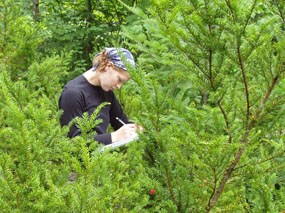
Apostle Islands National Lakeshore provides regionally diverse and unique plant communities. This is due primarily because it lies in the tension zone between the boreal and temperate forests. Thus, the islands and their forests comprise an ecosystem that is unique in North America. In pre-settlement times about 90% of the islands were covered by an upland mixed coniferous/hardwood forest dominated by hemlock, white pine, sugar maple, yellow and white birch. The boreal forest community was dominated by white spruce, balsam fir, tamarack, white cedar, birch, and aspen. Most of the islands have a history of logging, however some islands were not commercially logged (North Twin, Devils, Raspberry, Long, and Eagle) and others retain old growth forest remnants (e.g, Outer, Bear). 
Over 800 plant species occur within the lakeshore, including Wisconsin State listed endangered, threatened, and special concern species. Following logging, deer populations irrupted on many of the islands, severely impacting species favored by deer, such as Canada yew. Some islands had moderate-high deer densities, while others did not have a history of deer populations. Today, islands without a history of high deer densities support lush stands of Canada yew, a very rare species on the mainland mainly due to deer browse. Currently, deer populations occur on only a few islands. Wetlands within the lakeshore include bogs associated with sandscapes, perched bogs, lagoons, alder thickets and beaver flowages. These wetlands contain unique flora and fauna and add a considerable amount of ecological diversity to the lakeshore. Bogs dominated by sedges, wetland shrubs and sphagnum mosses often occur in the filled-in lake basins that are located just inland from sandscape dune ridges. The larger bogs on Michigan, Outer, and Stockton Islands have lagoons with floating and submersed aquatic species. Bogs found on poorly-drained summit plateaus are often smaller and have poorer bog floras than their coastal, sandscape counterparts. About one-third of the Islands coasts consist of Precambian sandstone ledges and bluffs. Local vegetation on these rock faces depend on the microhabitat and can vary from common willows and weed species, to subarctic rarities and species with calcareous tendencies. Steep reddish clay bluffs are vegetated with small trees of balsam poplar, white birch, red maple and showy mountain ash. The lakeshore has a rich assemblage of dunal features. Dunal vegetation, beach grass and beach pea, as well as a shrub and forest component of speckled alder, quaking aspen and white birch dominate these sandscapes. Select a Park:Select a Species Category (optional):
Search results will be displayed here.
|
Last updated: October 8, 2021
